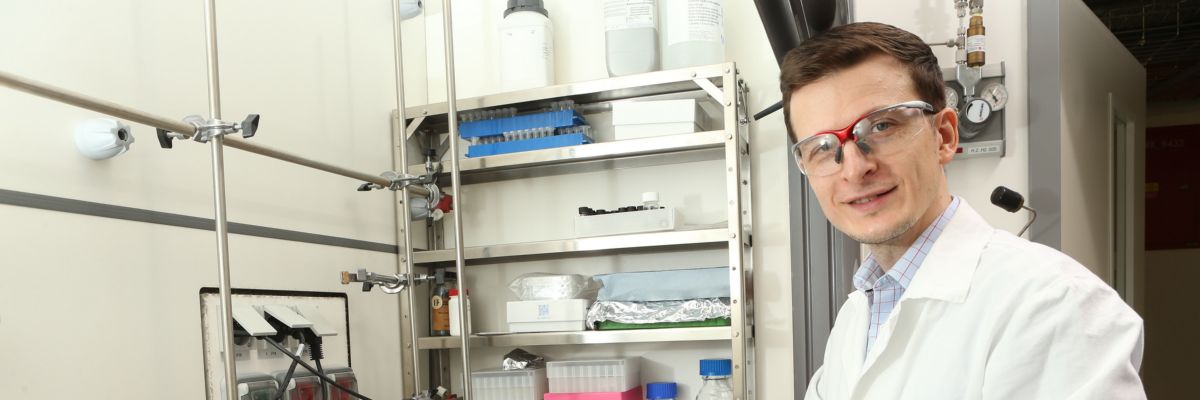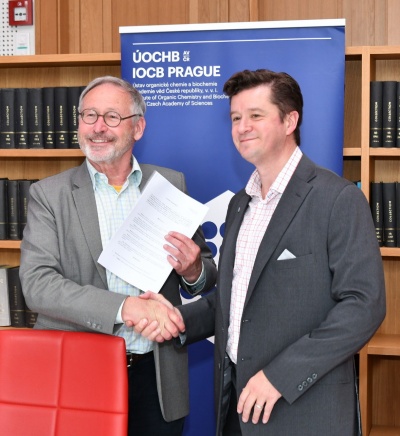
IOCB’s lutetium separation method will facilitate treatment of cancer
16. 05. 2019
A novel method for separating rare earth elements, developed at the Institute of Organic Chemistry and Biochemistry (IOCB) of the CAS, will make the production of radiopharmaceuticals faster and easier. IOCB has entered into an intellectual property license agreement with SHINE Medical Technologies, providing the American company an exclusive license to this method. SHINE will use the innovation to produce lutetium-177 (Lu-177) for treatment of cancer.
The separation technique was developed by the team of Dr. Miloslav Polášek, Head of IOCB’s Coordination Chemistry Research Group, which is devoted to advancing the fields of nuclear medicine and molecular imaging by providing new chemical tools.
“Separation of rare earth elements is notoriously difficult, particularly if they are radioactive and must be extremely pure. Our technology was developed specifically for this purpose and has a potential to improve speed and scale of Lu-177 production. As a scientist, I am thrilled that the years in the lab may bring a real-world application, especially if it helps cancer patients,” said Miloslav Polášek of IOCB.

IOCB director Zdeněk Hostomský and SHINE co-founder
Todd Asmuth at the signing of the agreement
The announcement comes one week after SHINE broke ground on their US medical isotope production facility in Janesville, Wisconsin. This facility will use SHINE’s platform technology to produce a variety of medical isotopes, including Lu-177. IOCB’s separation method will allow SHINE to rapidly and efficiently separate Lu-177 from irradiated ytterbium-176 targets, producing a highly concentrated Lu-177 product known as “non-carrier-added” or “high-specific-activity” Lu-177.
Making a difference in the world
“The Lu-177-based cancer therapeutics under development now show tremendous promise for doing a huge amount of good in the world,” said Greg Piefer, SHINE founder and CEO. “SHINE is committed to ensuring there is enough Lu-177 to meet demand as more and more patients benefit from these products. The IOCB technology is a key element of our strategy to get to market quickly.”
Founded in 2010, SHINE uses a patented manufacturing process that offers numerous advantages over other production technologies, as it does not require a nuclear reactor, uses less electricity, generates less waste, and is compatible with the United States’ existing supply chain for molybdenum-99.
“We are very excited about this cooperation and we believe it will result in helping all patients who could benefit from Lu-177 therapy,” said Martin Fusek, Deputy Director for Strategic Development at IOCB.
“The work Dr. Polášek is doing in this space is phenomenal. I hope that this is only the beginning of a long, mutually beneficial relationship between the IOCB Prague and SHINE,” said SHINE VP of Business Development, Katrina Pitas.
On the opening photo: Miloslav Polášek, Head of IOCB’s Coordination Chemistry Research Group
Prepared by: Dušan Brinzanik, Institute of Organic Chemistry and Biochemistry of the CAS, in cooperation with Milan Pohl, Department of Media Communication of the Head Office of the CAS
Photo: Institute of Organic Chemistry and Biochemistry of the CAS
Read also
- A trapped state: The pandemic impact on public attitudes, trust, and behavior
- Aerial archaeology: Tracing the footsteps of our ancestors from the sky
- Archaeologists uncover ancient finds along Prague Ring Road
- Our microbiome largely depends on what we eat, says microbiologist Michal Kraus
- The ABCs of writing: Why did its invention mark a turning point for humankind?
- We learn, remember, forget… What can memory actually do? And can we outsmart it?
- New Center for Electron Microscopy in Brno opens its doors to global science
- The hidden lives of waste: What can we learn from waste workers and pickers?
- A unique lab is hidden right beneath Prague’s Vítkov Hill
- Renewables are a strategic investment in European security, scientists say
The Czech Academy of Sciences (the CAS)
The mission of the CAS
The primary mission of the CAS is to conduct research in a broad spectrum of natural, technical and social sciences as well as humanities. This research aims to advance progress of scientific knowledge at the international level, considering, however, the specific needs of the Czech society and the national culture.
President of the CAS
Prof. Eva Zažímalová has started her second term of office in May 2021. She is a respected scientist, and a Professor of Plant Anatomy and Physiology.
She is also a part of GCSA of the EU.